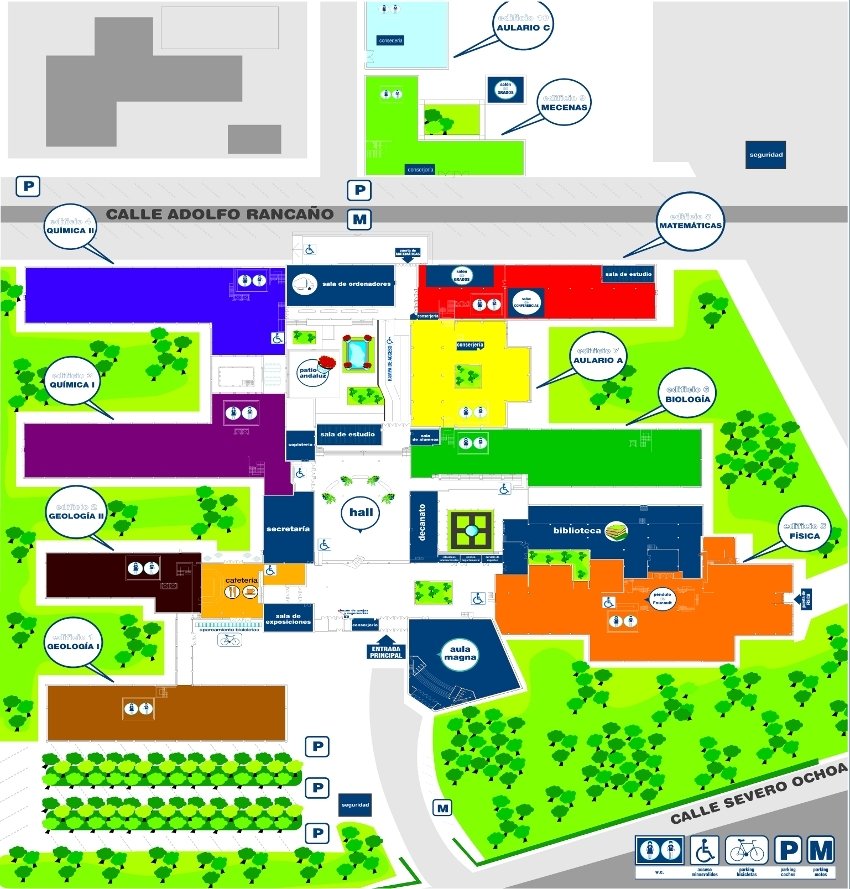Faculty
 As Dean of Sciences Faculty, it is a great pleasure for me to send regards to you in name of the whole university Community that our center forms. This old Faculty, found in 1857, makes an effort, course after course, in keeping jovial its spirit and in conforming to the new times, preserving its peculiarities and improving the levels of quality which have made the Sciences Faculty one of the most emblematic center in our University.
As Dean of Sciences Faculty, it is a great pleasure for me to send regards to you in name of the whole university Community that our center forms. This old Faculty, found in 1857, makes an effort, course after course, in keeping jovial its spirit and in conforming to the new times, preserving its peculiarities and improving the levels of quality which have made the Sciences Faculty one of the most emblematic center in our University.
The Sciences Faculty at University of Granada is, without doubt, a unique center. It is the Spanish Sciences Faculty that gives more Degree titles (currently, twelve Degree titles and one double title in Mathematics and Computer Science engineering). Around a thousand teachers are teaching in this faculty, close to a hundred members Administration and Services and almost six thousands of students receive teaching.
The complexity of this Faculty has required to provide it of a specific academic-administrative system, which makes attention in the peculiarities of each title and coordinate the teaching activities in a more suitable way. Thus, the Entitlements have a coordinator and a teaching committee, where the appropriate aspects of each one are organized. The general aspects of the coordination and the ensemble running is analyzed and decided by the committee of this Faculty and by the Government commission of it, in which the different center´ sectors are represented ( faculty, students and PAS) and the Departments with most number in teaching and they have the presence of the responsible in the different entitlements.
However, the Sciences Faculty is not just a great teaching center at University of Granada. It is also a scientific center where is generated more than the half of the investigation that is produced in our University. We would like that our students who are integrated in this Faculty would start to be considerated since a first moment as researches in power and to recognize the important role of the Sciences in the social development. Our intention is not just instruct good professional people, it is also to instruct promised people with the future and with social progress.
Finally, we would like to show the surety, of this Dean and the Government Team of this center, that the university formation should be comprehensive. Thus, the students who study in our Faculty will find a complete serie of educational activities which are organized by the Center itself, the different Entitlements, the Students Societies and the Departments. Through all of these, we try that our students learn the different scientific subjects which are in every entitlement, we try, over all, that they learn to be better people, with an open-mind and a critic spirit.
In representation of every member who contributes day after day with his effort, his ideas, his initiative and his participation for doing of this center the great Sciences Faculty at University of Granada, we are proud of our University, we send kind regards to you.
Best regards
Dean and Dean's Team of the Faculty of Sciences
Directions
The Faculty of Science is located on the Campus of Fuentenueva, accessible from the ring road of Granada, by the departure of Méndez Núñez.
Faculty Map
Contact
|
Fuente Nueva s/n 18071 Granada |
|
|
Tel: 958 24 33 72 / 73 / 74 / 76 |
|
| Fron monday to friday: 7:00 to 22:00 |
Schedule Secretarial: Fron monday to friday: 9:00 to 14:00
History and Overwiev of the Faculty
Throughout its history, Granada has been a settling place for several civilizations, such as the Iberians, the Romans, the Jews or the Muslims. At the end of the Muslim period, the Emirate of Granada, main city of the ancient Nasrid Kingdom, was the last resistance place of the Muslims on the Iberian Peninsula. The invasion of Granada by the Catholic Monarchs in 1492 put an end to a period of the Spanish history known as the Reconquista (Reconquest) and set the stage for the discovery of the Old World, which meant the meeting of both American and European cultures.
Granada is not only the last Muslim city in Western Europe, but also a Renaissance one: it is a witness of the glory of the Islamic civilization, as reflected in monuments like the Alhambra or the Generalife Gardens, and it also preserves an important historic heritage of the Renaissance period—the Royal Hospital and the Granada Cathedral are good examples of this legacy—.
Granada is located in an extraordinary site, halfway between sunny coasts and snowy mountains. By car, it is 60 minutes away from the Grenadian beaches, 75 minutes away from Malaga and 30 minutes away from the ski resort Sierra Nevada (3 400m).
The University of Granada was founded in 1531 by means of Clement VII’s papal bull at the initiative of Charles V. It succeeded the old Madrasah of Granada, founded by Yusuf I in 1349.
The University of Granada is an exceptional mirror of the history thanks to its 473 years of tradition. It has gradually expanded its influence in the social and cultural environment of Granada and it has become, in its own right, a cultural and intellectual model in the south of Spain for almost five centuries. During the last years, this growth has increased exponentially, making the University of Granada one of the best Spanish universities.
The Royal Hospital is the administrative and governing office of the University, as well as the rector’s office. The rest of facilities and schools are located in different places around the city and in the Fuentenueva and Cartuja campuses. This distribution, added to the 80 000 (of a total of 270 000) inhabitants of the capital directly related to the University of Granada as students, professors or administrative staff, gives the city a unique universitary appearance.
The Faculty of Sciences was founded in 1857 as a result of the Higher Education Regulatory Act (Moyano Law), which established the separation of the former faculties of Philosophy into two independent faculties: Sciences and Humanities. In 1913, modern science studies in the University of Granada became independent from Madrid, due to the creation of the Chemistry degree. Other studies started to be taught throughout the twentieth century: Geology in 1956, Mathematics in 1964, Biology in 1968, Physics in 1973, Computer Sciences in 1986, and Optometry and Statistics in 1989. In 1993, the Computer Sciences degree became an engineering and an independent faculty was founded. Between 1993 and 1997, other studies were added to the educational offerings of the new faculty: Chemical Engineering and Electronic Engineering in 1993, Biochemistry and Environmental Science in 1995 and Statistics in 1996-1997. At present, following the Bologna process, the old degrees have been discontinued and replaced with similar degrees that meet the requirements established by Bologna, and a new one, the Biotechnology degree, has been created in 2014.
In the last academic year, there were around 6 000 students in the Faculty of Sciences, being taught by almost one thousand professors of 40 different Departments and receiving support from the one hundred members of the administrative staff.
Faculty Photos






